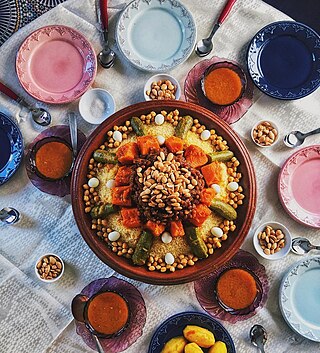
Couscous is a traditional North African dish of small steamed granules of rolled semolina that is often served with a stew spooned on top. Pearl millet, sorghum, bulgur, and other cereals are sometimes cooked in a similar way in other regions, and the resulting dishes are also sometimes called couscous.

Moroccan cuisine is the cuisine of Morocco, fueled by interactions and exchanges with many cultures and nations over the centuries. Moroccan cuisine is usually a mix of Arab, Berber, Andalusi, and Mediterranean cuisines, with minimal European and sub-Saharan influences. Like the rest of the Maghrebi cuisine, Moroccan cuisine has more in common with Middle Eastern cuisine than with the rest of Africa.

A tajine or tagine is a North African dish, named after the earthenware pot in which it is cooked. It is also called maraq or marqa.

Mediterranean cuisine is the food and methods of preparation used by the people of the Mediterranean Basin. The idea of a Mediterranean cuisine originates with the cookery writer Elizabeth David's book, A Book of Mediterranean Food (1950) and was amplified by other writers working in English.
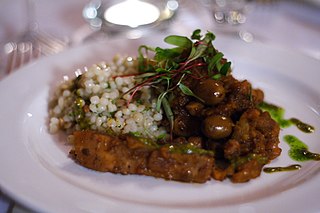
Chermoula or charmoula is a marinade and relish used in Algerian, Libyan, Moroccan and Tunisian cooking. It is traditionally used to flavor fish or seafood, but it can be used on other meats or vegetables. It is somewhat similar to the Latin American chimichurri.
African cuisine is a staple of the continent's culture, and its history is entwined with the story of the native people of Africa. The foods that native Africans eat have been influenced by their religions, as well as by their climates and lifestyles. The first Africans to inhabit the continent were hunter-gatherers who ate what they could find in nature. As agriculture became more common in Africa, so did agriculture-based diets.

Arab cuisine is the cuisine of the Arab world, defined as the various regional cuisines of the Arab people, spanning from the Maghreb to the Mashriq. These cuisines are centuries old and reflect the culture of trading in ingredients, spices, herbs, and commodities. The regions have many similarities, but also unique traditions. They have also been influenced by climate, cultivation, and mutual commerce.

Pastilla is a meat or seafood pie in Maghrebi cuisine made with warqa dough (ورقة), which is similar to filo. It is a specialty of Morocco, Algeria, and Tunisia, where its variation is known as malsouka. It has more recently been spread by emigrants to France, Israel, and North America.

Shakshouka is a Maghrebi dish of eggs poached in a sauce of tomatoes, olive oil, peppers, onion, and garlic, commonly spiced with cumin, paprika and cayenne pepper. According to Joan Nathan, shakshouka originated in Ottoman North Africa in the mid-16th century after tomatoes were introduced to the region by Hernán Cortés as part of the Columbian exchange. Shakshouka is a popular dish throughout the Middle East and North Africa.

Tagine malsouka, or malsouqa, is a Tunisian dish composed of sheets of malsouka dough, stuffed with a savory filling.

Sephardic Jewish cuisine is an assortment of cooking traditions that developed among the Sephardi Jews.

Tunisian cuisine, the cuisine of Tunisia, consists of the cooking traditions, ingredients, recipes and techniques developed in Tunisia since antiquity. It is mainly a blend of Mediterranean and native Punics-Berber cuisine. Historically, Tunisian cuisine witnessed influence and exchanges with many cultures and nations like Italians, Andalusians, French and Arabs.
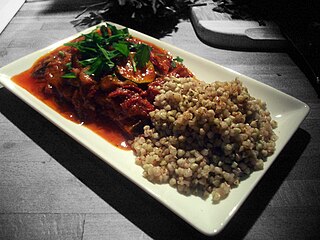
Ratatouille is a French Provençal dish of stewed vegetables that originated in Nice and is sometimes referred to as ratatouille niçoise. Recipes and cooking times differ widely, but common ingredients include tomato, garlic, onion, courgette (zucchini), aubergine, capsicum, and some combination of leafy green herbs common to the region, such as chives or fennel.
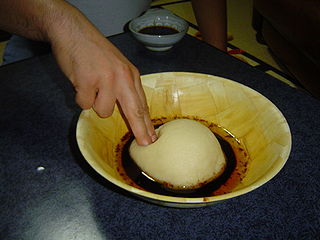
The cuisine of Libya is a mix of Berber, Arab and Mediterranean cuisines with Ottoman and Italian influence. One of the most popular Libyan dishes is bazin, an unleavened bread prepared with barley, water and salt. Bazin is prepared by boiling barley flour in water and then beating it to create a dough using a magraf, which is a unique stick designed for this purpose.

The cuisine of Algeria is influenced by Algeria's interactions and exchanges with other cultures and nations over the centuries. It is based on both land and sea products. Conquests or demographic movement towards the Algerian territory were two of the main factors of exchanges between the different peoples and cultures. The Algerian cuisine is a mix of Arab, Berber, Turkish and French roots.

Harissa is a hot chili pepper paste, native to the Maghreb. The main ingredients are roasted red peppers, Baklouti peppers (بقلوطي), spices and herbs such as garlic paste, caraway seeds, coriander seeds, cumin and olive oil to carry the oil-soluble flavors.

Western Saharan cuisine comprises the cuisine of Western Sahara, a disputed territory in the Maghreb region of North Africa, bordered by Morocco to the north, Algeria to the extreme northeast, Mauritania to the east and south, and the Atlantic Ocean to the west. The Western Saharan cuisine has several influences, as the population of that area (Sahrawi), in their most part are of Arabic and Berber origin. The Saharawi cuisine is also influenced by Spanish cuisine owing to Spanish colonisation.

Middle Eastern cuisine or West Asian cuisine includes a number of cuisines from the Middle East. Common ingredients include olives and olive oil, pitas, honey, sesame seeds, dates, sumac, chickpeas, mint, rice and parsley, and popular dishes include kebabs, dolmas, falafel, baklava, yogurt, doner kebab, shawarma and mulukhiyah.
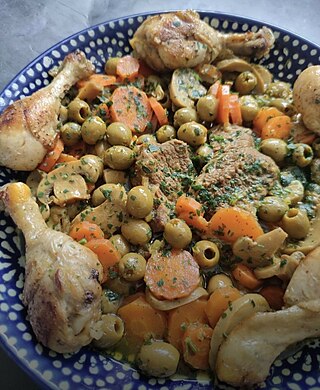
Tajine Zitoun or Tajine El Zitoune or Tagine Zitoune or Olive Tajine is a traditional Algerian stew from the city of Algiers. It is named after the earthenware pot in which it is cooked, a tajine pot. Tajine zitoun typically includes lamb, turkey or chicken and olives as the main ingredient, often also with some combination of onions, carrots, mushrooms or other vegetables, and is often seasoned with thyme, bay leaves, lemon juice, and saffron or turmeric. In Constantine, Algeria, the savory dish could be chicken or beef tongue simmered with only olives and mushrooms, or meatballs broken down, then cooked in sauce with mushrooms and olives.



























